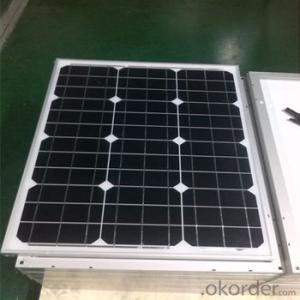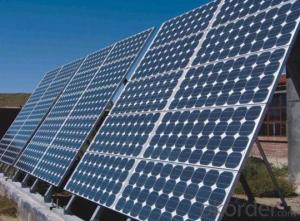40W Mini Monocrystalline Solar Panel CNBM
- Loading Port:
- Qingdao
- Payment Terms:
- TT OR LC
- Min Order Qty:
- 10 set
- Supply Capability:
- 300000 set/month
OKorder Service Pledge
OKorder Financial Service
You Might Also Like
Mini Monocrystalline Solar Panel with 40W
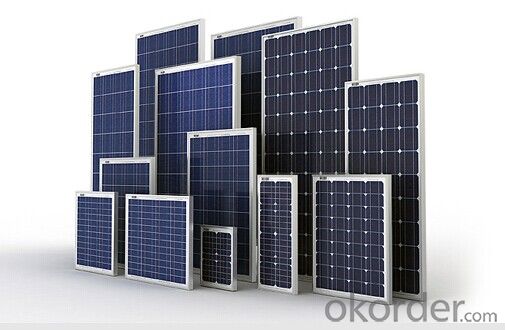
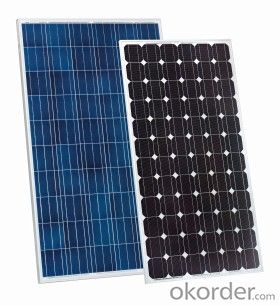
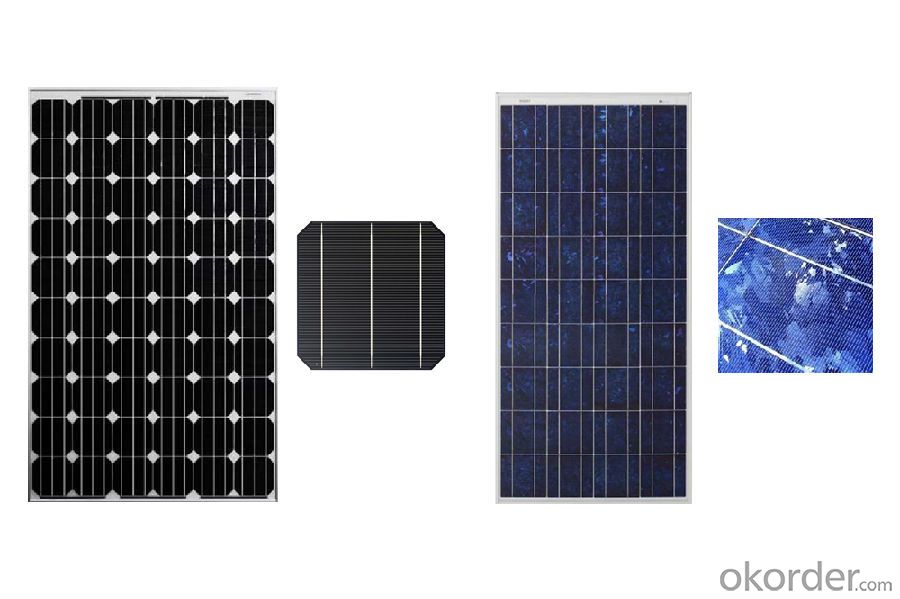
Monocrystalline Solar Modules
We offers a range of small, medium and large monocrystalline solar modules, designed for a range of requirements.
Specifications:
Tolerance | +/- 3% |
Cell | Monocrystalline silicon solar cells |
N0. of Cells | 72 (12 x 6) |
Dimension of Modules (mm) | 1581 x 809 x 40 |
Weight (kg) | 15.5 |
Limits:
Operating Temperature | -40~+85? |
Storage Temperature | -40~+85? |
Maximum System Voltage | 1000 VDC max. |
Hail Impact | Diameter of 28mm with impact speed of 86km/h |
Temperature and Coefficients:
NOCT | 48C+/-2? |
Voltage temperature coefficient (%/K) | -0.34 |
Current temperature coefficient (%/K) | 0.09 |
Power temperature coefficient (%/K) | -0.37 |
Characteristics:
Model: | SGM-160D | SGM-165D | SGM-170D |
Max-power voltage Vmp (V) | 34.5 | 35.4 | 35.8 |
Max-power current Imp (A) | 4.64 | 4.66 | 4.75 |
Open-circuit voltage Voc (V) | 41.75 | 43.6 | 43.32 |
Short-Circuit Current Isc (A) | 5.32 | 5.08 | 5.38 |
Max-power Pm(W) | 160 | 165 | 170 |
Model: | SGM-175D | SGM-180D | SGM-185D |
Max-power voltage Vmp (V) | 36.1 | 36.2 | 36.2 |
Max-power current Imp (A) | 4.85 | 4.97 | 5.11 |
Open-circuit voltage Voc (V) | 43.68 | 43.8 | 44.8 |
Short-Circuit Current Isc (A) | 5.49 | 5.48 | 5.51 |
Max-power Pm(W) | 175 | 180 | 185 |
STC: Irradiance 1000W/m2, Module temperature 25?, AM=1.5
Monocrystalline Solar Panels Specifications Range
Maximum Power (Pm) | Dimension | Weight | Operating Voltage (Vmp) | Operating Current (Imp) | Open Circuit Voltage (Voc) | Short Circuit Current (Isc) |
3W | 158x241x25mm | 0.5kg | 8.5V | 0.36A | 10.5V | 0.4A |
4W | 308x166x25mm | 0.77kg | 8.5V | 0.47A | 10.5V | 0.54A |
4W | 308.x166x25mm | 0.77kg | 16.8V | 0.24A | 21V | 0.27A |
5W | 296x215x25mm | 0.3kg | 16.8V | 0.48a | 21V | 0.54A |
10W | 286x406x25mm | 1.5kg | 16.8V | 0.59A | 21V | 0.66A |
12W | 286x406x25mm | 1.5kg | 16.8V | 0.71A | 21V | 0.8A |
14W | 286x541x25mm | 2kg | 16.8V | 0.83A | 21V | 0.96A |
16W | 286x541x25mm | 2kg | 17.2V | 0.93A | 21.5V | 0.99A |
18W | 296x541x25mm | 2.4kg | 18.8V | 1.07A | 21V | 1.2A |
20W | 296x641x25mm | 2.4kg | 17.2V | 1.15A | 21.5V | 1.24A |
24W | 541x451x25mm | 3.15kg | 16.8V | 1.14A | 21V | 1.56A |
26W | 541x451x25mm | 3.15kg | 17.2V | 1.51A | 21.5V | 1.63A |
30W | 296x966x25mm | 3.85kg | 16.8V | 1.78A | 21V | 2.03A |
36W | 541x641x35mm | 4.7kg | 16.8V | 2.14a | 21V | 2.4A |
40W | 541x641x35mm | 4.7kg | 17.2V | 2.33A | 21.5V | 2.5A |
55W | 1057x457x35mm | 6.6kg | 17.6V | 3.12A | 21.6V | 3.3A |
70W | 546x1196x35mm | 8.5kg | 16.8V | 4.15A | 21V | 4.7A |
75W | 546x1196x35mm | 8.5kg | 17.2V | 4.36A | 21.5V | 4.8A |
80W | 546x1196x35mm | 8.5kg | 17.6V | 4.55A | 21.6V | 4.9A |
110W | 1066x811x40mm | 11.8kg | 17.6V | 6.25A | 21.6V | 6.6A |
150W | 1066x811x40mm | 14kg | 34.4V | 4.36A | 43.2V | 4.7A |
- Q:I know that one LED can't power a solar panel. I have found 40 kmcd LED's on OKorder. I know that several of them (28 totale each one with a 470 ohm resistor all at 2 VDC) can show a reflection on a wall in daylight 60 feet away..
- The 40 kmcd rating is a measure of luminous intensity (how bright it looks), not a measure of output power of the visible light. We can estimate the performance of your proposed system as follows: The LEDs on OKorder each are rated about 20mA maximum at about 3.2V, or 64mW (milliwatts). If you use 470 ohm resistors connected to 2VDC, the current that will flow, per LED, will be about: (2V-3.2V)/470ohm = 0.0872A = 8.72mA The power taken from the 2VDC power source will be: P2v = 2V x 8.72mA = 224.6mW (per LED) The power input to each LED will be about: Pled = 3.2V x 8.72mA = 59.9mW (per LED) The LED has a luminous efficiency that can range from about 4.2% to 22%. This efficiency is the ratio of the amount of visible light output (in watts) divided by the input power (in watts). The OKorder listing doesn't identify the output power level (either in watts or in lumens), so let's assume a 0% efficiency. The LED output power will be about: Pout = 59.9mW x 0% = 5.99mW (per LED) A solar panel converts visible light to electrical energy with an efficiency that ranges say about 6% to 8%. Suppose the solar panel efficiency is 2%. Then the electrical power output by the panel will be about : Pe = 5.99mW x 2% = 0.72mW (per LED) If you shine 00 LEDs on the panel, the output electrical power will be 00 times that amount: Pe00 = 0.72mW/LED x 00 LED = 72mW <===ANSWER The power taken from your 2V source will be about: P2V00 = 224.6mW/LED x 00 LED = 22460mW = 22.46W The system efficiency will be about: Eff = solar output / battery input = Pe00 / P2V00 = 72mW / 22460mW x 00% = 0.32% SUMMARY: If you shine 00 of the LEDs on the panel, you will capture back about 0.32% of the energy expended, or regain about 72mW.
- Q:Can solar panels be installed on warehouses or industrial facilities?
- Yes, solar panels can definitely be installed on warehouses or industrial facilities. In fact, these large commercial buildings often have ample space on their roofs or surrounding areas, making them ideal locations for solar panel installations. By harnessing renewable energy from the sun, warehouses and industrial facilities can reduce their reliance on traditional energy sources, lower their electricity costs, and contribute to a more sustainable future.
- Q:what is one benifit in a solar panel?
- Solar panels can be used for main grid connection, remote power with batteries, remote solar lighting, on vehicles or boats. Solar panels have a life of up to 30 years. The energy used to make a solar panel is recovered and solar panels can even make an income. Green power can be sold back to the grid at premium prices in some places around the world.
- Q:How do solar panels affect the roof's integrity?
- Solar panels generally do not affect the roof's integrity when installed properly. In fact, they can even extend the roof's lifespan by providing protection from elements like sunlight, rain, and snow. However, it is crucial to hire experienced professionals for installation to ensure proper mounting and sealing, avoiding any potential damage to the roof.
- Q:Can solar panels be installed on a government building?
- Yes, solar panels can be installed on a government building. In fact, many government buildings have already implemented solar energy systems to reduce their carbon footprint and lower energy costs.
- Q:Can solar panels be used to power a restaurant?
- Yes, solar panels can be used to power a restaurant. By installing solar panels on the rooftop or in a nearby area, the restaurant can generate clean and renewable energy to meet its electricity needs. These panels convert sunlight into electricity, which can power various appliances, lighting, and other electrical systems within the restaurant. Additionally, solar panels can help reduce the restaurant's reliance on the traditional power grid, leading to potential cost savings and environmental benefits.
- Q:How do solar panels affect the property's energy resilience?
- Solar panels can greatly increase a property's energy resilience by generating clean and renewable electricity on-site. By harnessing the power of the sun, solar panels provide a reliable source of energy that can offset or even eliminate the need for grid-supplied electricity. This reduces dependence on fossil fuels and the vulnerability to power outages or price fluctuations. Additionally, solar panels can often store excess energy in batteries, allowing for uninterrupted power supply during emergencies or blackouts. Overall, solar panels contribute to a more resilient and self-sufficient energy system for the property.
- Q:How are solar panels made?
- Solar panels are made using a multi-step process that involves the production of silicon wafers, the application of various layers and coatings, and the assembly of individual cells into a panel.
- Q:Can solar panels be installed on remote or off-grid locations?
- Yes, solar panels can be installed on remote or off-grid locations. In fact, they are particularly suitable for such locations as they do not require a connection to the traditional power grid. Solar panels can generate electricity by harnessing sunlight, making them a reliable and sustainable energy source for remote areas.
- Q:Can solar panels generate electricity at night?
- No, solar panels cannot generate electricity at night because they rely on sunlight to produce power.
1. Manufacturer Overview |
|
|---|---|
| Location | |
| Year Established | |
| Annual Output Value | |
| Main Markets | |
| Company Certifications | |
2. Manufacturer Certificates |
|
|---|---|
| a) Certification Name | |
| Range | |
| Reference | |
| Validity Period | |
3. Manufacturer Capability |
|
|---|---|
| a)Trade Capacity | |
| Nearest Port | |
| Export Percentage | |
| No.of Employees in Trade Department | |
| Language Spoken: | |
| b)Factory Information | |
| Factory Size: | |
| No. of Production Lines | |
| Contract Manufacturing | |
| Product Price Range | |
Send your message to us
40W Mini Monocrystalline Solar Panel CNBM
- Loading Port:
- Qingdao
- Payment Terms:
- TT OR LC
- Min Order Qty:
- 10 set
- Supply Capability:
- 300000 set/month
OKorder Service Pledge
OKorder Financial Service
Similar products
New products
Hot products
Hot Searches
Related keywords







